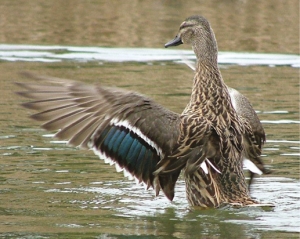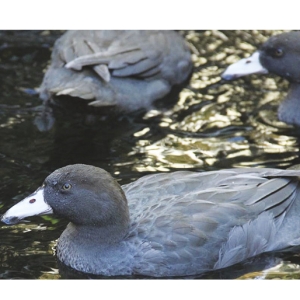Displaying items by tag: Waterfowl
Operation Duck Pond
With about 90 percent of New Zealand’s wetland lost over the past 150 years, Fish & Game NZ realises there’s a compelling need to assess the role that ponds play in successfully managing waterfowl.
Ponds have been established across the New Zealand landscape for various purposes including stock watering, irrigation, storm water capture, effluent ponding, waterfowl habitat and simple aesthetic values. Currently, there’s little scientific information on what, and how big a role these ponds play as habitat for waterfowl populations.
The aim of this ‘citizen science’ project is to determine what pond habitat features provide good breeding for waterfowl, and promote good pond management practices for breeding these birds. Fish & Game has launched an appeal for people who want to monitor waterfowl populations on ponds around their area. The aim is to establish a network of ponds to be closely monitored over the breeding season.
You don’t have to be a scientist! All volunteers will be given a set of simple instructions on how to go about monitoring. Fish & Game will supply a manual with simple instructions on how to run their surveys – so everyone round the country is tackling the project the same way, and volunteers gather the best data possible.
If you’re keen to help with collection of data and are prepared to monitor a pond, a fun and fulfilling project that will help New Zealand’s waterfowl and other native water dependant birds, this project is for you. Don’t forget – we are keen to hear from a wide range of people, including youngsters. Kids – depending on your age, you may need to line up support from mum and dad, a friend or relation.
Your help in this project will not only provide data to drive management decisions, but will give waterfowl enthusiasts, hunters and landowners a unique opportunity to get involved and make a real hands on contribution to our efforts to manage waterfowl – and keep their numbers up!
Keep a weather eye on the birds
Back in March 2017, near Pokeno on the F&G McKenzie Wetland Block near Pokeno, one hour south of Auckland off SH1 we were banding grey teal there. If DU members could keep an eye out for these I would be pleased to hear about them.
Now for BOW – this is a pond specially reserved for people who pass our course of how to shoot clay targets, dress (pluck) game, tie trout flies, cast a trout rod and there’s a nice salmon meal in a tent to finish with.
The Dean Block is a F&G wetland near Pokeno and BOW pond is part of that. There’s about 50 grey teal nest boxes there and more on the adjoining McKenzie Block.
BOW means Becoming an Outdoor Woman. The lady who did this, Shonagh Lindsay, has since moved on, which means the programme Grey Teal 1: Good spot – Fish and Game. Dabchicks: Dabchicks at BOW pond. is currently suspended. We took women of all ages and shooting coaches Brian Thompson or Bill McLeod taught them how to shoot a shotgun at clay targets. I taught them how to dress a duck and then cooked it for them, (Schnitzel-style). The Auckland Anglers club taught them how to fly-cast with a trout rod. Sally Spiers and her daughter showed them how to tie a trout fly in the tent, (they fished the one they tied themselves – a Woolly Buggar – that’s actually what it is called, (it was Sally Spiers who chose it). We then gave them a chance to catch a fish near Waikino, (near Waihi).
It was a popular two-day programme, and we did feed them salmon in a F&G tent, Paul Matos was the professional chef who donated his time for many of these. But eventually everyone who wanted to give it a go did so and bookings in Auckland dried up. Northland Fish & Game also did some for several years with equal success. We were strongly hoping other F&G regions would pick up the proven programme.
I think the main idea is that many woman would like to give these things a go with their men-folk but perhaps lack confidence. We thought if we taught them the basics, they’d join in. After all, if their father, husband, boyfriend or brother already had the gear, the know-how and the places to go. We thought the inspired, initiated and more confident women could now go with them. The feedback was very positive and it seemed everyone, trainers and trainees, had a lot of fun doing it.
John Dyer
Whio in decline
Whio in decline…
The whio (blue duck) is one of New Zealand’s ancient endemic waterfowl species and is classified as Threatened (Nationally Vulnerable) in the New Zealand Threat Classification System 2012, and listed as Endangered on the IUCN Red List of Threatened Species.
North Island and South Island whio populations are genetically distinct (though they are not described as sub-species) and are treated as separate management units. The whio has experienced rapid declines (particularly in the South Island) in abundance and distribution, nowhere common. It lives at low densities in severely fragmented populations. The most recent estimate of total population numbered 1200 pairs at most.
The most notable decline driver comes from introduced mammalian predators, with predation of eggs, young and incubating females. Stoats are the most significant threat and stoat control is a main focus of management activities.
The blue duck’s widespread decline throughout South Island beech forests areas has highlighted the insidious effects of mast-seeding beech trees, which result in great predation pressure, as rodent populations explode, causing a lagged increase in stoat populations which seek alternative prey when rodent numbers crash. A malebiased sex-ratio throughout the range, indicates that predation during incubation is significant.
One of the major conservation management tools for whio is captive breeding for release into the wild. The blue duck has been held in captivity for many years, and its husbandry requirements are understood. The aim is to maximise productivity of the captive breeding programme, and ensure that captive-bred ducklings are released at the highest priority sites. Captive breeding has proven highly effective, and is vital in aiding the recovery programme with the re-establishment and rebuilding of viable populations throughout the former range.
The Isaac Conservation and Wildlife Trust provides the largest output of blue duck juveniles annually, with its waterfowl aviaries being the most successful captive breeding enclosures in New Zealand for North Island blue duck. The Trust currently holds two North Island blue duck breeding pairs. These breeding pairs can lay up to three clutches per season, with an average of six eggs per clutch. All eggs are collected for incubation and hand rearing.
The Trust is a significant participant in the WHIONE programme, which consists of retrieving wild eggs each breeding season from South Island pairs for artificial incubation and rearing in captivity, with a subsequent release of juveniles once fledglings have been hardened in our fast water facilities and are at a lower risk of predation. Releases take place in natal territories or at new sites around the South Island to increase numbers and genetic diversity across sites or re-establish lost populations. Since 2016 the Trust has been retaining cohorts of South Island blue duck juveniles for flock mating, to initiate a captive breeding population across several South Island facilities. The Trust will move out of North Island birds and hold three pairs of the South Island blue duck.
Each season for the last 12 years, the Trust has also received North Island blue duck juveniles bred by other captive institutions nationwide, which are transferred for pre-conditioning in fast flowing raceways prior to release into the wild.
Sabrina Luecht
Wildlife Project Administrator
The Isaac Conservation and Wildlife Trust


